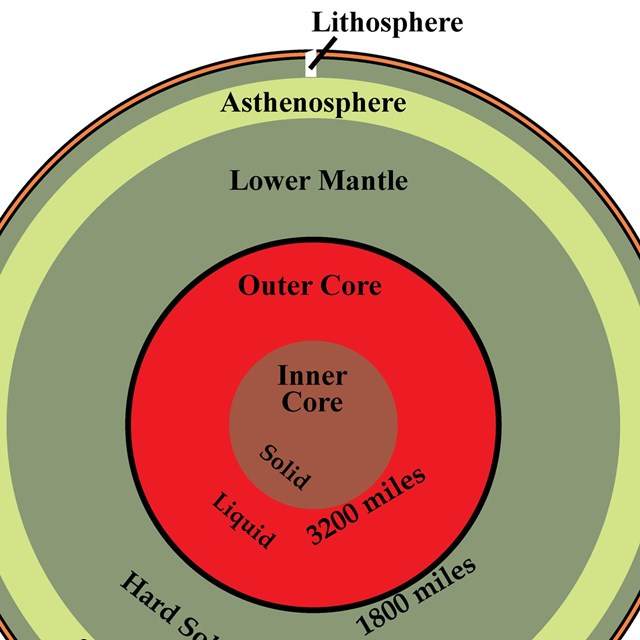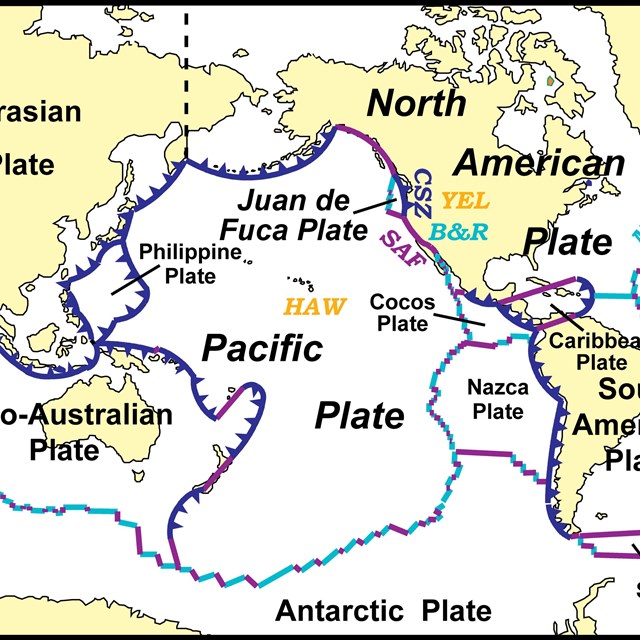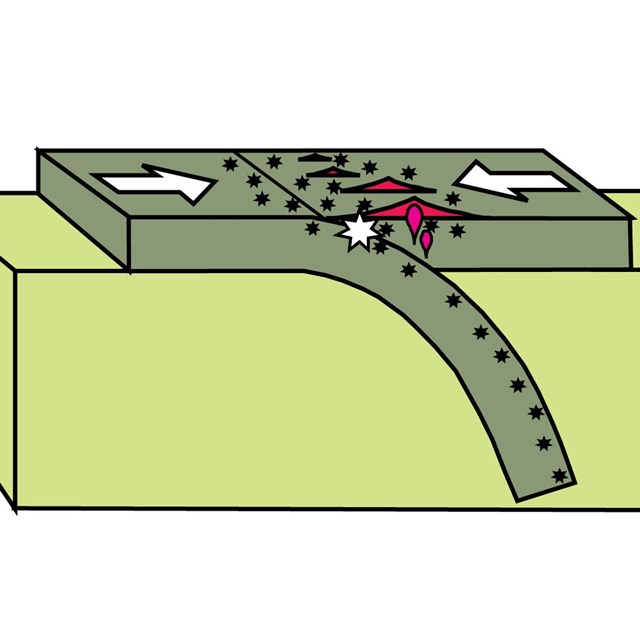
Modified from “Beauty from the Beast: Plate Tectonics and the Landscapes of the Pacific Northwest,” by Robert J. Lillie, Wells Creek Publishers, 92 pp., 2015, www.amazon.com/dp/1512211893).
The Action is at The Edges
So why is there so much tectonic activity (earthquakes, volcanic eruptions and the formation of mountain ranges) in the western United States compared to the East? Tectonic activity commonly occurs along the boundaries of the moving plates. The Pacific coast of the United States coincides with plate boundaries and thus has earthquakes, volcanic eruptions, and developing mountain ranges. The Atlantic and Gulf coasts, though initially formed from plate-boundary activity, are now far from any plate boundaries and accompanying tectonic events.
Mountain Building
Most mountain ranges are long and narrow because they form at plate boundaries or hotspots. The largest mountain range on Earth is the system of mid-ocean ridges, a line of underwater volcanoes formed on the seafloor as plates diverge. Plate divergence sometimes rips a continent apart, forming long mountain ranges separated by deep rift valleys. Where plates converge along an active continental margin, the one with thin oceanic crust descends (“subducts”) beneath the continent, forming two parallel mountain ranges. One is a coastal range consisting of material squeezed up out of the sea, the other a volcanic chain farther inland above where hot water rises from the descending plate. The highest mountains on Earth, the Himalayas, are forming where thick blocks of continental crust (India and Asia) collide as a result of plate convergence. Sheared-up mountain ridges and valleys form in a narrow zone where one plate slides past another at a transform plate boundary. And a mountain chain of volcanoes forms where a plate rides over a hotspot; the volcanoes get older and lower as the plate moves them away from the hotspot.
Related Links—Mountain Building
Volcanic Eruptions
Volcanic activity occurs above places in the Earth where pressure, temperature, and the presence of water conspire to melt rock. There are two main ways Earth materials melt: 1) hot mantle rises and decompresses; and 2) water flows through hot rock. The first type of melting occurs at diverging plate boundaries (mid-ocean ridges; continental rift zones) and hotspots, where mantle beneath plates is hot but remains solid because it is under great pressure. As the hot mantle rises, sudden drop in pressure causes melting, much as taking the lid off a pressure cooker causes super-heated water to flash to steam. The second mechanism results in volcanism at convergent plate boundaries. As one plate dives (subducts) beneath the other, it heats up and releases hot fluids (similar to the way we sweat when we get hot). The fluids (mostly water) rise, wetting hot rock in their path and causing some of the rock to melt.
Related Links—Volcanic Eruptions
Earthquakes
Two things are necessary for earthquakes to occur: 1) motion within the Earth that stresses and deforms material; and 2) material that deforms by breaking rather than flowing. Moving plates of cold, brittle lithosphere produce most earthquakes, especially where they are contorted and grind against one another along their boundaries.
Related Links—Earthquakes
Geoscience Concepts—Plate Tectonics
Figures Used
Related Links
Site Index & Credits
Plate Tectonics and Our National Parks
- Plate Tectonics—The Unifying Theory of Geology
- Inner Earth Model
- Evidence of Plate Motions
- Types of Plate Boundaries
- Tectonic Settings of NPS Sites—Master List
Teaching Resources—Plate Tectonics
Photos and Multimedia—Plate Tectonics
Geological Monitoring—Plate Tectonics
Plate Tectonics and Our National Parks (2020)
-
Text and Illustrations by Robert J. Lillie, Emeritus Professor of Geosciences, Oregon State University [E-mail]
-
Produced under a Cooperative Agreement for earth science education between the National Park Service's Geologic Resources Division and the American Geosciences Institute.
Last updated: February 11, 2020



